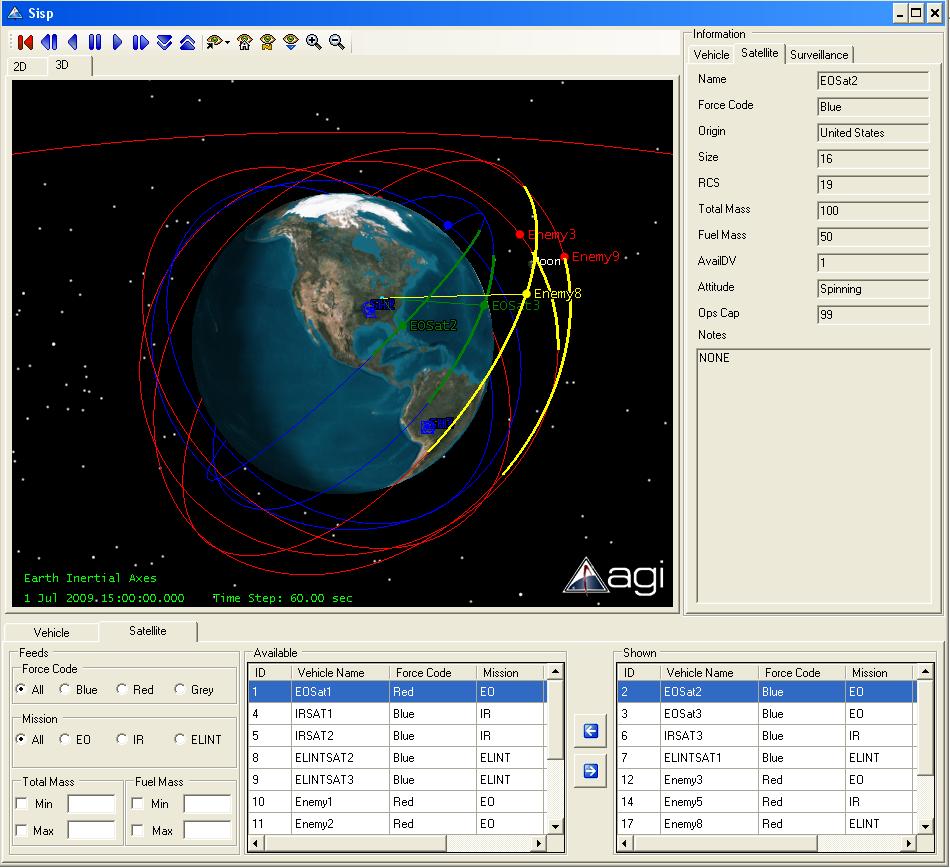
Note: Although the example that accompanies this shipment is in C#, the following discussion is focused on aspects of the reference application that are applicable and important regardless of programming language.
This shipment of the STK Engine is accompanied by an application that illustrates some of the ways in which you can leverage STK Engine embedded technology in your custom, stand-alone applications. The example used here is an application called Single Integrated Space Picture (SISP), designed to provide information on satellites and other assets of interest to the user at a glance.

This application, together with source files in C# (see note above, however), are located at:
<STK install folder>/CodeSamples/CustomApplications/CSharp/Sisp
To load the SISP application, please open the solution file in the directory referenced above in Visual Studio 2013, Visual Studio 2012, or Visual Studio 2010. That directory also contains a text version of the full C# source code (SISPSource.txt).
When the application is launched, the constructor
SispForm() is invoked, which contains the following
line:
stkRoot = new AGI.STKObjects.AgStkObjectRoot();
This line instantiates an instance of STK Automation Object Model. The Object Model is designed to make it easy for users to build custom solutions using STK Engine. It provides developers with capabilities to control and automate STK objects, manage the lifetime of STK objects, access Data Provider Tools, perform access and coverage computations, and respond to events generated by STK. It is the preferred way of accessing and manipulating STK.
When the application's main form is loaded,
SispForm_Load() event is called, which contains the
following line.
stkRoot.NewScenario("SISP");
The above line uses the object model to create a new scenario.
If you browse through the application code, you will see that the
objects model is used extensively to access STK's analytical and
visualization capabilities - creating and defining objects,
calculating access, etc. For example, in the
SispForm_Load() event, mentioned above, object model
methods and properties are used to create and define a new scenario
and to add a facility and set properties.
Another illustration of effective use of the Object model is in
the event addVehicleShown_Click(object sender, EventArgs
e), which implements the button used for moving great arc
vehicles from a vehicles 'Available' list to a vehicles 'Shown'
list.

Looping through the selected vehicles list, this event repeatedly calls an AddVehicle(...) function that creates a new vehicle and sets waypoints and various graphics properties for it on each iteration. Ordinarily, the graphics display in the Globe window would be updated every time that a vehicle is added. To prevent this and thereby improve performance, the addVehicleShown_Click event calls an object model method 'stkRoot.BeginUpdate()' to suspend graphics updating before beginning the loop through the selected vehicles list and calls 'stkRoot.EndUpdate()' afterwards to resume updating.
Before you move on to the next section, you may want to take a few minutes to explore the STK X Help System. STK X Help contains a wealth of information on the ActiveX components shipped with STK X, including code samples in other .NET languages (Visual Basic, C#, etc.) and C++.
Another way of accessing and manipulating STK is via sending
Connect commands. A member of the
axAgUiAxVOCntrl1.Application property, the
ExecuteCommand method, is used for sending Connect
commands to be processed by STK. In the accompanying C# code, the
method is invoked in the function SendCommand(string
command) through the following line:
rVal = this.axAgUiAxVOCntrl1.Application.ExecuteCommand(command);
The help page for the ExecuteCommand method contains important Connect command formatting information and links to:
If you browse through the accompanying code listing, you will see that the ExecuteCommand method (via the SendCommand function) is used a few times in communicating with STK.
The event globe_DblClick () retrieves various kinds
of information about an object that is double-clicked on the Globe
control and uses it to update various data displays in the
application. The globe_DblClick() event calls
UpdateFacility() method to accomplish this. This
method includes three calls to functions that invoke the
AgPickInfoData object:
private void UpdateFacility()
{
...
x = Int32.Parse(suvellanceXTextBox.Text);
y = Int32.Parse(suvellanceYTextBox.Text);
path = PickObjectInfo(x, y);
...
if (survAccessOn)
{suvellanceLatitudeTextBox.Text = Convert.ToString(PickInfoLat(x, y));
suvellanceLongitudeTextBox.Text = Convert.ToString(PickInfoLon(x, y));
...
}
The values in suvellanceXTextBox.Text and
suvellanceYTextBox.Text were set globally in
axAgUiAxVOCntrl1_MouseMoveEvent event on the Globe
control:
private AgPickInfoData SetPickInfoData(int x, int y)
{
...}
else if (globeViewTabControl.SelectedIndex == GLOBETAP_INDEX_3D)
{
return axAgUiAxVOCntrl1.PickInfo(x, y);}
return null;
The PickInfo method processes the point clicked and
returns an AgPickInfoData object that contains (if
available) the corresponding 3D scene latitude, longitude and
altitude and the STK object (if any) at that location. When that
object is returned to the calling function --
PickObjectInfo, for example -- specific information is
extracted from it -- here, the ObjPath string:
private string PickObjectInfo(int x, int y)
{
AgPickInfoData pickInfoData;{
pickInfoData = SetPickInfoData(x, y);
return pickInfoData.ObjPath;
For example, it might return the string
"/Application/STK/Scenario/Test/Satellite/tle-08747".
Finally, when returned to UpdateFacility() function,
the string is used in updating the application's data displays. The
PickInfoLat and PickInfoLon functions
work similarly, returning position information from the
AgPickInfoData.Lat and AgPickInfoData.Lon
properties, respectively.
Another method of the axAgUiAxVOCntrl1 object is
the ZoomIn method, which is invoked by code
implementing a button on the application's GUI:
private void zoomInVO_Click(object sender, EventArgs e)
{
if (globeViewTabControl.SelectedIndex == GLOBETAP_INDEX_3D)axAgUiAxVOCntrl1.ZoomIn();}
...
Many of the remaining methods and functions of the reference application include calls to various object model objects, methods and properties. A number of sample custom applications in different programming languages are provided.
STK Programming Interface 11.0.1